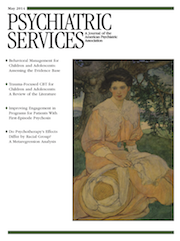Conflicts Among CMHC Clinicians Over the Role of Urine Drug Testing
To the Editor: Urine drug testing is standard practice in addiction treatment (1,2), but we know little about its use in community mental health centers (CMHCs), where most treatment occurs for individuals with co-occurring mental and substance use disorders (3). With the advent of affordable, self-reading urine drug-screening cups, an examination of the potential use of urine drug testing in CMHCs is timely.
We conducted a survey with 24 bachelor’s- and master’s-level clinicians experienced in working with individuals with co-occurring disorders. The study was conducted in the mental health services department at an urban CMHC, in which a separate department is state certified for provision of drug and alcohol treatment. In the mental health services department, urine toxicology testing is conducted at clinicians’ discretion and is not mandated by state regulations. However, such testing is mandated in the state-certified addiction treatment department.
Participants were asked about the extent to which they had used or would like to use urine drug testing and about the associated strengths and challenges of using them. To familiarize staff with testing, we provided a supply of self-reading urine test cups and a brief training in their use. In addition to being given to the 24 clinicians surveyed, the cups were also offered to 31 staff members in the mental health services department (total N=55).
Ten of the 24 survey respondents (42%) had used urine drug screening to monitor substance use, although only one had used self-reading test cups. Seven (29%) had used urine drug screening when it was court ordered for a client, but very few had used it in any other context. However, many more wanted to use drug testing for a range of treatment purposes, including assessing (N=20, 83%) and treating (N=17, 71%) substance use, at the request of prescribers (N=8, 33%), for diagnostic clarification (N=8, 33%), to show a client’s readiness for employment (N=7, 29%) or housing (N=4, 17%), and in routine treatment (N=7, 29%). Clinicians reported that testing could serve as a basis for reinforcement of abstinence and could also help guide payeeship decisions, identify stages of change, and “keep clients honest” in reporting substance use.
The most common concern, raised by more than half of the surveyed clinicians (N=13, 54%), was that testing could worsen the clinical relationship by putting clinicians in a potentially authoritarian role that might remind clients of past experiences with testing in forensic settings. Also, only 12 clinicians (50%) felt that urine drug testing fit within a harm reduction model, whereas others suggested it was more consistent with an abstinence-only approach. All stressed that testing should be optional and its purpose discussed clearly with the client.
Self-reading urine test cups were viewed as an easy and useful way to provide immediate, accurate feedback. However, after three months, only 20 (36%) of the 55 clinicians had used them. Most had used only one or two cups.
Our results showed that although CMHC clinicians endorsed the utility of urine drug testing, they expressed significant concerns that testing could erode clinical relationships and may be challenging to conceptualize within a mental health recovery and harm reduction framework. Although the small sample limits our ability to draw firm conclusions, the study suggests that urine drug testing will not be easily adopted in CMHCs. Regarding the pros and cons of urine drug testing in CMHCs, certain questions should be addressed: Do CMHC clinicians view substance use assessment as part of their job? Are clinicians trained to test for substance use? Are drug testing methods available? Under what circumstances do clinicians find discretionary testing most useful? Do their views differ by type of substance or whether testing is required in formal addiction treatment settings (such as for medication-assisted treatment for opioid addiction)? How can the clinical utility of urine drug testing be balanced against the perception of stigma and the association of testing with legal consequences?
1 : Primary outcome indices in illicit drug dependence treatment research: systematic approach to selection and measurement of drug use end-points in clinical trials. Addiction 107:694–708, 2012Crossref, Medline, Google Scholar
2 : Drug use, self report and urinalysis. Drug and Alcohol Dependence 58:111–116, 2000Crossref, Medline, Google Scholar
3 Substance Abuse Treatment for Persons With Co-Occurring Disorders. Treatment Improvement Protocol Series 42. DHHS pub no (SMA) 05-3992. Rockville, Md, Substance Abuse and Mental Health Services Administration, Center for Substance Abuse Treatment, 2005Google Scholar



